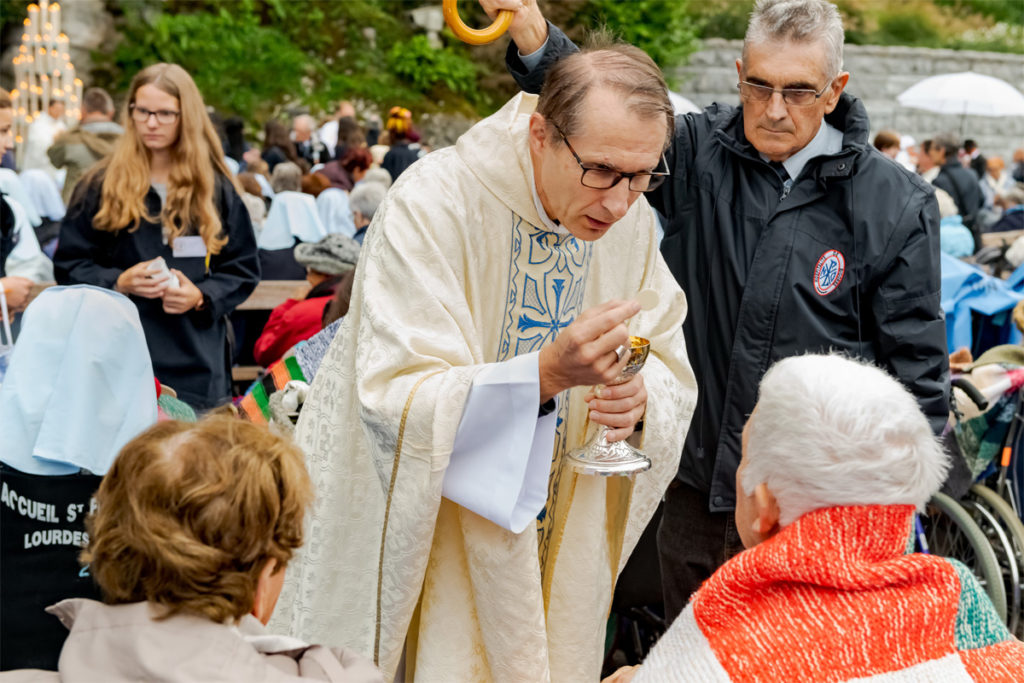Before plunging in the daily life of meetings, service activities and celebrations, those who go to the Shrine of Lourdes in France for the first time, are struck by three facts: the sick can be seen in this town, they are everywhere; they crowd the immense area of the Shrine and the surrounding streets on wheelchairs or stretchers: the beautiful and vulnerable humanity, here, shows itself completely, unlike what happens in the hectic streets of the great western cities, where the sick seem almost disappeared. The second fact is the climate you breathe. This place – which like a hospitable womb collects the pain, the anxieties, the sufferings of thousands of people – is not dominated by a dark sense of despair, but a light breeze of tenacious hope and mild reliance on the Lord. The third fact is the gestures of care and concern, the firm, kind and obstinate complicity against the evil that ignites among people, each aware of their own vulnerability.
On the occasion of the official opening of the pilgrimage season, which began on April 7, 56 year-old Father Nicolas Brouwet, Bishop of Tarbes and Lourdes, tells Vatican Insider about the life at the Shrine and the significance of this 2019 dedicated to Bernadette Soubirous, the 14-year-old young woman (this year celebrating the 175th anniversary of her birth and the 140th anniversary of her death) to whom Our Lady repeatedly appeared in 1858.
Why has 2019 been declared the Year of Bernadette ?
“Each year, a theme is chosen to provide pilgrims a sort of new gateway to the pilgrimage experience. Reflecting with the Rector of the Shrine, Father André Cabes, on the first evangelical beatitude – “Blessed are you, poor, for your is the kingdom of God” (Lk 6:20) – we realized that Bernadette had fully lived this beatitude and that therefore the pilgrims could understand and live the evangelical words thanks to this young saint and her life”.
What faces does poverty take on in Bernadette’s life ?
“I am convinced that Bernadette is a figure for our time. Many men and women wonder with pain and bewilderment whether they still hold a place in society: this question, at least here in France, has unfortunately become frequent: in the face of a well-organized and “winning” elite there is a deeply uncomfortable crowd, made of many who feel excluded and left aside. Little Bernadette would be part of this crowd: she was the last one in Lourdes and the Lord looked at her, the last one, with tenderness, calling her to see Mary and to be her messenger. God forgets no one.
It should be noted that Bernadette’s poverty was not romantic. She suffered material misery with her family and was afflicted by physical poverty, illness, which prevented her from doing much of what she would have liked, for example going to school and following the catechism; her poverty was also spiritual. And then there was the poverty of he character: Bernadette was stubborn, she was impulsive: she knew it and fought against her temperament. But she was humble: she let herself be led by the Church, both when she lived in Lourdes and later, in the convent of Nevers. She lived obedience, which for her was not natural: she wanted to be a daughter of the Church even when it cost her many efforts: for example, when, invited by her parish priest or superior, she had to meet the people who wanted to meet her”.
What can Bernadette teach the men and women of our time ?
“She teaches us how to stand before God: with simplicity, in an authentic way, without hiding our poverty. And she teaches us to receive, through Mary’s smile, the mercy and tenderness of the Father. Lourdes is a place of truth: here the pilgrims understand that, like Bernadette, they can stand “naked” before God, with their weaknesses, their sins, their wounds, dropping the masks worn to defend themselves or to give a false image of themselves, ceasing to want to make a good impression in front of others.
And I think that, after Bernadette, it is the sick who evangelize us because they present themselves to the cave as they are: weak, fragile, vulnerable. And in doing so they help us to overcome resistance, pride, the presumption of not needing God. I think it is for this reason that in Lourdes a great many people, after dropping their masks, approach the sacrament of confession”.
In an age of strong individualism like ours, dominated by the diktat of stripping oneself of ties or debts to anyone, how does the experience of a pilgrimage to Lourdes instruct the younger generations ?
“The pilgrimage – and I see it in the many young people who come here every year – teaches us to rediscover direct contact with our neighbour, to experience the weakness that we allow ourselves to serve, and to feel natural to take care of those in need, to receive what good others have to offer: the young people need to learn both to give and to receive with gratitude and humility the gifts that enrich their lives and help them to become adults”.
At Lourdes, humanity shows itself in its entirety: here the sick can be seen. And they are honored.
“It is true! When I first came on pilgrimage to the Shrine as a teenager, I was struck by the visibility of the sick who in the big cities were and are kept apart, hidden, because they want to hide their weakness, as if it were an obstacle or a limit to be removed even from sight. Not so in Lourdes: I often say that here we experience an overturned society, in which the little ones are honored and the reality of the human being is shown in its entirety. And also in its variety of languages, cultures, traditions. One could say that Lourdes is a beautiful image of the Church: not of the bureaucratic one, but of the Catholic Church, universal, in which one lives in the love for the Lord, in praise of Him through the liturgy, and one takes care of one another, beginning with the most fragile, according to the commandment of Jesus. The authentic spirit of Lourdes was well narrated in a magnificent documentary dedicated to pilgrimages – made precisely on the occasion of the Year of Bernadette – which will be released in France on 8 May and which I know has already been translated into Italian”.

Seventy healings, considered inexplicable by science, took place in Lourdes, of which the Church has recognized the prodigious and miraculous character and the value of divine sign. But they are not the only miracles of Lourdes.
“That’s right. The miraculous healings are a visible sign of the care that the Lord has for each of us, of what He does in the human heart, of the invisible graces that people receive daily: they are countless. On the site of the Shrine we wanted to introduce a space where pilgrims can tell the wonders done by the Lord for them, the invisible miracles. There are those who, for example, have approached the sacrament of confession after decades, those who have made peace with a family member, those who have decided to take care of others, those who, in prayer, have found peace. I could give a great many examples”.
How would you describe your experience as pastor at the head of the diocese of Tarbes and Lourdes?
“I am doubly committed because in addition to the pastoral care of the parishes (entrusted to fifty priests), there is also the care of the Shrine (in which about thirty priests work). I consider it a grace to be able to lead this diocese. For example: it is a grace for me to be able to welcome pilgrims, to discover the beauty of the different spirituality that Christianity has generated and to see that everyone, with Mary, feels at home. In Lourdes, there is a living experience of ecclesial communion. During the pilgrimage season every Wednesday I also invite the bishops who have come here with their groups of faithful to lunch: I have the opportunity to learn about the life of the people of God scattered throughout the world. And it’s not just a saying: pilgrims from Italy, France and Western Europe are fewer in number than in the past, while the number of faithful coming from faraway countries is increasing, such as, for example, China (about two thousand faithful every year), Korea, India, Sri Lanka, the Philippines, and, more recently, also South America. Wishing to welcome these pilgrims, since we do not know their languages, we decided to host small communities of nuns from these countries who generously made themselves available to carry out the reception service. We try to do our part so that everyone can feel at home”.
Cristina Uguccioni (Vatican Insider)





